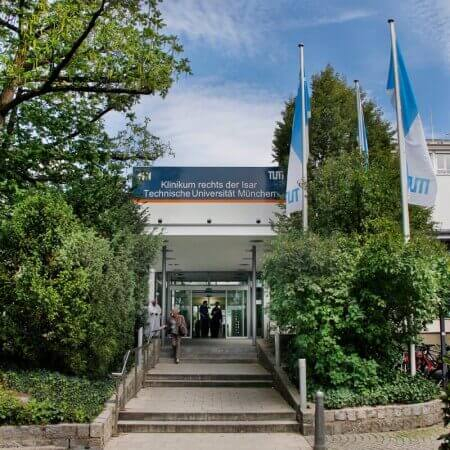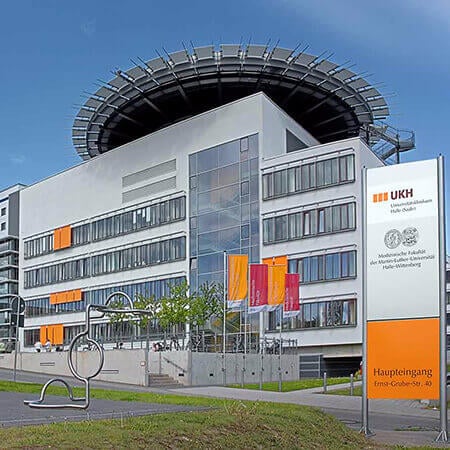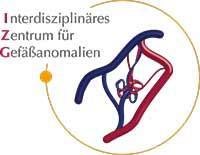Neuroendocrine Tumor (NET) of the Lung — Embolization or Chemoembolization: treatment in the Best Hospitals of Germany
Treatment prices are regulated by national law of the corresponding countries, but can also include additional hospital coefficients. In order to receive the individual cost calculation, please send us the request and medical records.

Department of Interventional Radiology
The Department of Interventional Radiology offers the full range of imaging examinations, as well as innovative image-guided minimally invasive techniques for the treatment of tumors, vascular diseases and internal pathologies (for example, CT, MRI, PET-CT, SPECT). The department's doctors have deep knowledge and colossal experience in the field of interventional radiological methods of treatment, which represent an excellent alternative to open surgical interventions. Despite the high level of technical equipment and the presence of advanced computerized systems, the focus is always on the person with his individual needs. Compliance with current clinical protocols and high professionalism of the department's specialists contribute to the successful clinical practice, as well as the reputability of the department among the best medical facilities of this kind in Germany.




Department of Interventional Radiology and Neuroradiology
The Department of Interventional Radiology and Neuroradiology offers a full range of advanced imaging diagnostics and minimally invasive treatments on both an inpatient and outpatient basis. The department has state-of-the-art medical equipment for imaging tests such as X-ray, computed tomography, magnetic resonance imaging, digital subtraction angiography, and mammography. The medical facility also performs many highly effective interventional therapeutic procedures under image guidance, which in many cases allow patients to avoid traumatic open surgery. For example, the department successfully performs local fibrinolysis, thrombectomy, percutaneous transluminal angioplasty, hemostasis, transarterial chemoembolization, uterine artery embolization, and other procedures. The department's neuroradiologists specialize in brain and spinal cord imaging and the treatment of central nervous system disorders. Interventional neuroradiology focuses on the treatment of carotid artery stenosis, brain aneurysms, arteriovenous malformations, dural fistulas, subdural hematomas, brain tumors, skull base and spinal tumors, and chronic back pain. The department's medical team has extensive clinical experience in their areas of expertise. The specialists are guided by the recommendations of the German Society for Interventional Radiology and Minimally Invasive Therapy (DeGIR) and the German Society for Neuroradiology (DGNR), which helps to achieve the best results.






Department of Adult and Pediatric Diagnostic, Interventional Radiology, Neuroradiology
The Department of Adult and Pediatric Diagnostic, Interventional Radiology, Neuroradiology is one of the best institutions of its kind in Germany and offers patients the full range of radiological studies and imaging-guided minimally invasive therapy. The department’s scope of tasks also includes imaging diagnostics in children of all age groups, detection and invasive treatment of cerebral vascular pathology (neuroradiology). Patient care is provided both on an inpatient and outpatient basis.






The lungs are one of the two main locations of neuroendocrine tumors (NETs), along with the digestive tract, accounting for up to 25% of all cases. Unlike lung cancer, smoking and other risk factors are not the cause of NETs. These tumors develop sporadically and without any obvious reason. NETs come in varying grades. They are often malignant in the lungs, and 20% of patients already have metastases at the time of diagnostics. These patients are inoperable, but even in these cases, there is still the possibility of long-term tumor control with systemic therapy, radiation therapy, or chemoembolization.
Content
- How are lung neuroendocrine tumors treated?
- What are embolization and chemoembolization?
- In which cases can embolization be used?
- How is chemoembolization performed?
- Where can I undergo cancer treatment?
How are lung neuroendocrine tumors treated?
Lung tumors are divided into G1, G2, and G3 according to their grade. Benign and intermediate tumors are usually treated with surgery. Other procedures are used only when clinically indicated.
G3 tumor grade, which is called neuroendocrine lung cancer, requires combination treatment. These neoplasms are represented by the following two variants: large-cell and small-cell tumors.
In developed countries, operations are often performed using minimally invasive techniques, such as VATS or robot-assisted surgery. As with cancer treatment, depending on the location, stage, size, and grade of the tumor, doctors can perform thoracoscopic lobectomy, Da Vinci lobectomy, remove one segment of the lung, perform segmental resection, or perform extended pneumonectomy. Bronchoplasty and angioplasty procedures are also performed when a part of the lung is removed by crossing large bronchi and blood vessels. These are complex operations, but they preserve more lung parenchyma and therefore provide better respiratory function.
Below are some additional procedures after surgical treatment:
- G1 tumors are cured in the vast majority of cases, with a recurrence rate of less than 3%. Radiation therapy after surgery is only required for residual tumors.
- In G2, surgery provides a five-year survival rate in 95% of cases and a ten-year survival rate in 56% of cases. Radiation therapy after total tumor resection is required only in cases of elevated mitotic index and metastases in the lymph nodes.
- In cases of G3 lung neuroendocrine tumors, most patients have an unresectable tumor at the time of detection. In some patients, the tumor can be removed, and chemoradiation therapy is required after lung resection to lower the risk of recurrence.
For patients with unresectable tumors, chemoradiation therapy or systemic drug therapy are used.
What are embolization and chemoembolization?
Embolization is a minimally invasive endovascular procedure that involves blocking the arteries supplying the tumor. Their lumen is closed for the following purposes:
- Elimination of pulmonary hemorrhage and hemoptysis
- Depriving the tumor of blood supply
The tumor grows rapidly, so it consumes a significant amount of oxygen and nutrients. This is the reason why the tumor requires intense blood flow to deliver it. Therefore, any malignant tumor releases substances that activate angiogenesis, the process of forming new blood vessels. Pathological tissues are supplied with a network of arteries that provide fast-dividing cells with nutrients. At the same time, they are very sensitive to a lack of blood supply. When doctors block the blood flow, a significant part of the cancerous tumor dies.
Chemoembolization differs in that embolization is supplemented with regional chemotherapy. In classical chemoembolization, the embolizing agent and the chemotherapy drug are administered separately. In recent years, chemoembolization with drug-saturated microspheres has been increasingly used. In this case, the embolus initially contains the chemotherapy drug or is saturated with it just before the procedure.
Chemoembolization is preferred over embolization of the bleeding vessels if the main goal of treatment is local control of the malignancy. After delivery into the blood vessels, the emboli continuously release chemotherapy drugs that damage cancer cells. As a result, the effectiveness of the endovascular procedure increases.
In which cases can embolization be used?
Embolization and chemoembolization can be used for lung neuroendocrine tumor treatment for the following purposes:
- Shrinkage and control of unresectable lung tumors in patients who have contraindications or have already received radiation therapy
- Control of liver metastases (lung NETs have a high incidence of liver and bone metastases)
- Elimination and prevention of hemoptysis and pulmonary hemorrhage
Chemoembolization is a cytoreductive procedure. Unlike radical surgery, it cannot eliminate the tumor completely but aims to shrink the size of the tumor.
In cases of lung NETs, surgery is considered the best option for treating the disease. However, if it is impossible, doctors perform cytoreductive treatment. The primary method of tumor suppression is irradiation, but it may be contraindicated for some patients. In addition, the effect of irradiation or proton therapy is temporary. After a few months or a few years, the tumor recurs, and revision chemoradiation therapy is not carried out. In such cases, the most effective treatment option is chemoembolization.
This method has the following benefits:
- A minimally invasive procedure
- The treatment procedure is well tolerated
- There is no need for prolonged hospitalization and rehabilitation
- It has minimal contraindications
- It is suitable even for elderly and debilitated patients
- It does not cause any severe complications
- It ensures rapid improvement of the patient's health after the procedure
- In addition to shrinking the size of the tumor, it has the additional effect of eliminating hemoptysis and preventing pulmonary hemorrhages
How is chemoembolization performed?
Chemoembolization is performed in the radiosurgery operating room. This is a minimally invasive manipulation, so general anesthesia is not required. Doctors use local anesthesia in the incision area in combination with intravenous sedation, so the patient's consciousness is suppressed but contact with them is maintained.
An incision is made in the groin area, so the doctor approaches the femoral artery. The specialist delivers a catheter to the blood vessels in the lung. With a contrast agent and X-ray scanning, the doctor detects the sources of blood supply to the tumor and injects emboli into them. As a rule, these are tiny balls of varying diameters, saturated with chemotherapy drugs. Most often, the bronchial arteries have to be occluded, but sometimes other blood vessels can also be embolized if the lung neuroendocrine tumor has multiple sources of blood supply.
The procedure may also be performed to reduce liver metastases. In this case, doctors will block branches of the hepatic artery with emboli. Embolization to suppress metastases makes sense only if good local control of the primary tumor in the lung and general control of the cancer with systemic therapy are achieved.
Where can I undergo cancer treatment?
If you need high-quality medical care, you can undergo your neuroendocrine tumor of the lung treatment in Germany. Doctors at the leading medical centers in the country perform chemoembolization of bronchial arteries and other blood vessels using a minimally invasive method, safely, and with good results.
You can find out the cost of treatment and make your treatment appointment through the Booking Health service at a favorable price. The best hospitals for lung NET treatment in Germany are presented on our website. The Booking Health specialists will help you select the most suitable clinic and arrange your trip to Germany.
Authors:
The article was edited by medical experts, board-certified doctors Dr. Nadezhda Ivanisova and Dr. Vadim Zhiliuk. For the treatment of the conditions referred to in the article, you must consult a doctor; the information in the article is not intended for self-medication!
Sources:

